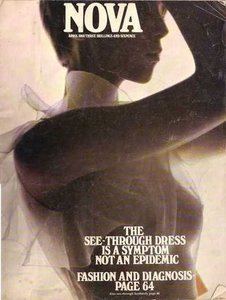 | ||
Nova, published from March 1965 to October 1975, was a British magazine that has been described as "a politically radical, beautifully designed, intellectual women's magazine. In 1965 it discussed sex and the Pill, and epitomised the sophistication of London with its bold type and white space." For its day, Nova's agenda of journalistically taboo subjects included contraception, abortion, cancer, race, homosexuality, divorce and royal affairs, invariably boosted by agenda-setting cover images, making it unique among magazines. It was Nova's courageous second editor, Dennis Hackett, together with visionary art director Harri Peccinotti, who swiftly established their magazine as an influential must-read for the movers and shakers of Swinging London, with men as well as the original target audience of women becoming devotees of its heady mixture of social issues and cutting-edge fashion and modern lifestyle features.
History
Founded by the agenda-setting magazine publishing company George Newnes, part of the International Publishing Corporation (known informally as IPC), Nova was initially edited by Harry Fieldhouse and described itself as "the new kind of magazine for a new kind of woman". From its seventh edition Dennis Hackett took over as editor with Kevin d'Arcy as assistant editor, Harri Peccinotti as art editor, Alma Birk as editorial adviser, with Penny Vincenzi and later Molly Parkin as fashion editors. The distinctive Nova font, adapted by Pentagram from an old woodcut typeface, became a formative influence on typography for many years.
At Nova, Peccinotti became one of the first professional photographers to use black models extensively in his fashion shoots. He stated in an interview: “Nova started as an experiment. The thinking behind it came from the fact that there were no magazines at the time for intelligent women... The women’s liberation movement was strong and there were a lot of good female writers. Nova’s aim was to talk about what women were really interested in: politics, careers, health, sex. George Newnes threw some money in, just to see if anyone was interested in a magazine like that, and so it started.”
Contributors to Nova included such notable and disparate writers as Graham Greene, Lynda Lee-Potter, Christopher Booker, Susan Sontag, and agony aunt Irma Kurtz. Nova also published the autobiographical writing of Arthur Hopcraft, later expanded into his 1970 book The Great Apple Raid and Other Encounters of a Tin Chapel Tiro. In the early 1970s it featured experimental "impressionistic" fashion photographs by Helmut Newton, Don McCullin, Hans Feurer and Terence Donovan. Illustrators included Mel Calman and Stewart Mackinnon.
Nova was famous in publishing circles as a woman's magazine that had more male than female readers, which was central to its financial decline.
The magazine was revived in May 2000, but it lasted just 13 issues, closing with its June 2001 issue.
